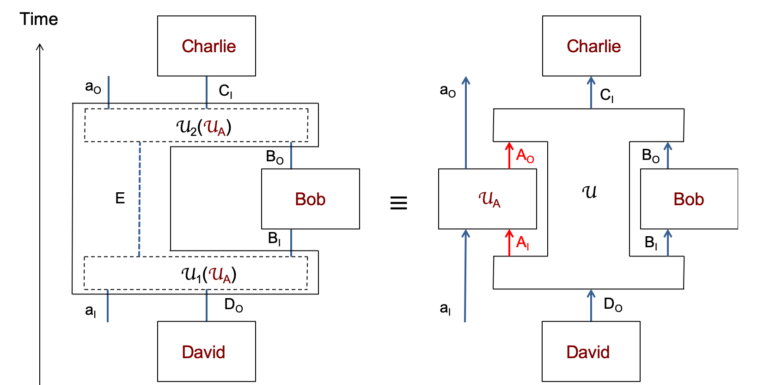When studying a complex system, scientists identify smaller pieces called subsystems that they can make sense of. By studying subsystems and the correlations between them, they reconstruct an understanding of the whole.
This approach has been used with great success to explain phenomena and develop applications based on quantum mechanics—the physics of matter and energy at the scale of the atom or smaller. But it largely describes systems that operate in a world where time is absolute.
It falls short when describing scenarios that consider Einstein’s theory of general relativity, where time is relative and tightly interwoven with space into a four-dimensional spacetime.
Now, a theoretical study co-authored by Alexander Smith, adjunct assistant professor of physics, and Shadi Ali Ahmad ’22, proposes a new framework for identifying subsystems and correlations in a way that is compatible with general relativity.
Their work may be applied in constructing a quantum description of spacetime, says Smith. Theoretical physicists have long been striving to combine quantum mechanics and general relativity into the unified theory of quantum gravity. Attempts to finally reconcile these fundamentally different theories that describe the universe have been progressing in the last two decades.
The new framework, published in April in the Physical Review Letters journal, builds on previous work on subsystems by the James Frank Family Professor of Physics Lorenza Viola and her collaborators.
“Quantum mechanics allows for correlations that are not consistent with our classical understanding of the world,” says Smith. Viola and her collaborators gave us a new way to think about these quirky quantum correlations, he says. In their framework, instead of having composite building parts that are glued together into a larger system, the subsystems arise from the complex system based on the kinds of measurements that one can make.
Smith, Ahmad and their collaborators apply this idea to build a framework for identifying subsystems, which is consistent with relativity theory, and find that the notion of the subsystem is no longer objective.
“The way we partition a system is also relative. It depends on who is looking at it,” says Smith. While their method currently applies to simple systems, the authors are working to generalize the framework.
Several theoretical concepts that are driving the emerging understanding of quantum gravity have their origin in quantum information theory—a relatively new field that studies how information in a quantum system can be analyzed and manipulated. “Quantum information science has given us this whole new way to think about quantum mechanics itself,” says Smith.
Working with Smith and other researchers, Ahmad, who is from Beirut, Lebanon, and majored in physics and mathematics, has used quantum information theory to study a number of different theoretical problems.
In previous work, published in Physical Review D, they were the first to examine how gravitational waves—ripples in spacetime caused when massive astronomical objects speed up to extreme levels—affect entanglement between systems.
Another project, published in Physical Review A, tackles the question of how work—the measure of how much energy is transferred when a force acts on an object—can be defined at the quantum scale.
Smith says Ahmad is one of the most driven to learn, hardworking, and productive students he has encountered. “Seeing Shadi develop his ability in theoretical physics over the past four years has been very rewarding,” he says.
Ahmad won the 2022 Gazzaniga Family Science Award, which recognizes scientific accomplishment of a graduating senior in the sciences. He is also the recipient of the Physics and Astronomy Chair’s Prize.
“Quantum information theory is a toolbox that I like to borrow from and use broadly,” says Ahmad. The promise of access to undergraduate research opportunities and funding was what drew him to Dartmouth, he says. Now a research fellow at Dartmouth, Ahmad is wrapping up ongoing projects as he prepares to apply to graduate programs.
With classes as a springboard, he sought out research mentors in the physics and mathematics departments, collaborating with them on a wide range of research topics.
“Talking about science with people shapes the way you think,” says Ahmad, who already has three publications under his belt. “I think it really sharpens your interest.”
More information:
Shadi Ali Ahmad et al, Quantum Relativity of Subsystems, Physical Review Letters (2022). DOI: 10.1103/PhysRevLett.128.170401
Shadi Ali Ahmad et al, Finite-resolution ancilla-assisted measurements of quantum work distributions, Physical Review A (2022). DOI: 10.1103/PhysRevA.105.052411
Qidong Xu et al, Gravitational waves affect vacuum entanglement, Physical Review D (2020). DOI: 10.1103/PhysRevD.102.065019
Citation:
A new theory of quantum subsystems (2022, July 26)



